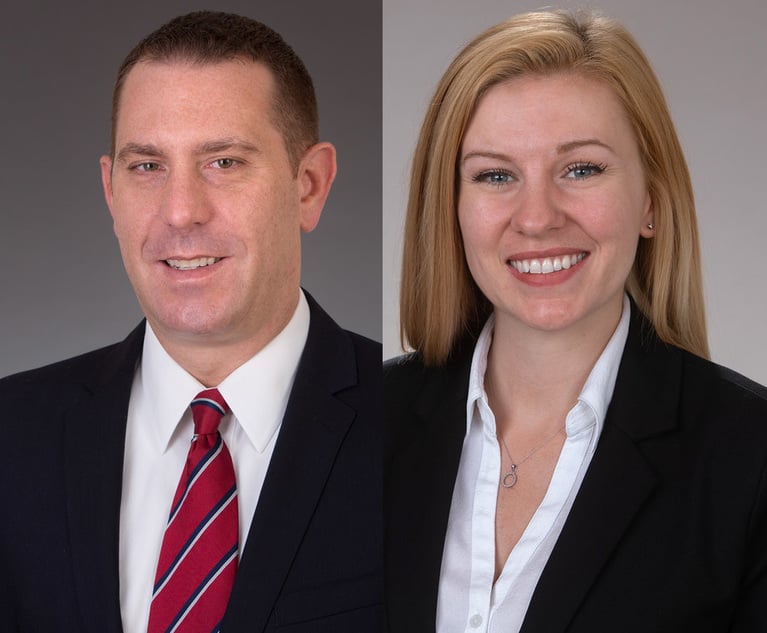How to Address Website Accessibility Issues Now
After years of inaction by the Department of Justice, courts have begun to address the issue of website accessibility under the Americans with Disabilities Act.
March 14, 2018 at 10:00 AM
5 minute read

After years of inaction by the Department of Justice, courts have begun to address the issue of website accessibility under the Americans with Disabilities Act. As one court recently noted: “Web accessibility is about ensuring that all people are able to use the web regardless of any physical or mental disabilities.” It would behoove all businesses that have customer-facing websites to take steps to ensure they are equally accessible to everyone on the internet. In Gil v. Winn Dixie, a federal court in Florida found that supermarket giant Winn Dixie violated the ADA because its website was inaccessible to a sight-impaired plaintiff. The court ordered Winn Dixie to make corrections and to pay plaintiff's attorney fees for taking the matter to trial. Below, I discuss how companies might avoid Winn Dixie's fate.
Accessibility Standards
First, website owners should check whether their website and other customer-facing applications meet accessible standards. A simple web search can provide a myriad of online tools for checking accessibility. According to Tony Pizzi, president of TechSpring, an international software development and technology consulting firm that advises law firms and other businesses on technology compliance and security issues, “online web accessibility evaluation tools can be helpful in identifying accessibility issues. These tools provide automated checks and can be utilized throughout all phases of design and development. However, manual review and human judgement are still required, as very often evaluation tools produce false positives and misleading results.”
Determining what standard to adopt is a question that stymied Winn Dixie. With the Department of Justice recently abandoning a proposed ruling, there is no federal organization or rule that mandates requirements for accessibility. A good place to start for guidance is with the World Wide Web Consortium (W3C), a group of member organizations whose mission is to develop standards for the World Wide Web. W3C has developed Web Content Accessibility Guidelines (WCAG) as part of a series of web accessibility guidelines published by their Web Accessibility Initiative (WAI). The current version, WCAG 2.0, was published in December 2008 and became an International Organization for Standardization (ISO) standard in October 2012 (ISO/IEC 40500:2012).
The Winn Dixie court described WCAG 2.0 as the “industry standard” for accessibility and noted that the federal government has virtually adopted the WCAG guidelines in Section 508 of the Federal Rehabilitation Act (which requires federal agencies to make electronic and information technology accessible to people with disabilities). WCAG guidelines have been adopted by thousands of e-commerce businesses to make websites accessible to the site-impaired. At a minimum, websites should seek alignment with W3C WCAG 2.0 Guidelines.
Accessibility should not be limited to screen readers. Websites could allow adjustable font and color contrast to provide for individuals with sight impairments. Individuals with limited manual dexterity may use speech recognition software that may only be effective with compatible websites. Videos and multi-media presentations should have captions for access by deaf individuals. Online forms often require timed responses or contain other elements that provide barriers to accessibility. We can expect future court decisions will begin to address many of these issues. Website operators need to be aware of the ever-changing technology available to disabled website users.
What Action to Take Now—A Potential Safe-Harbor?
While website operators would be wise to begin reviewing for compliance, common sense and practicality dictate that changes will not come overnight. The ADA requires “reasonable accommodations” and that term is subject to interpretation. For immediate action, however, the Winn Dixie court may have provided a clue. In discussing Winn Dixie's inaction, the court noted: “An accessibility notice is put on a website by the creator to showcase that the website is working diligently to create a better experience for the low-vision or blind users. No accessibility notice was found on the Winn Dixie website. Nothing on the Winn Dixie website announced any proposed changes to be made in 2017.”
Was the court suggesting that Winn Dixie's outcome may have been different had it posted such notice? Indeed, would it be reasonable for a plaintiff to file suit against a website owner who posts a notice acknowledging changes are needed and will be forthcoming? One is left to wonder if the court has offered website owners who post a similar (and bona fide) accessibility notice a safe-harbor. Use the Winn Dixie decision to get to work checking your website, work diligently to make corrections, and in the meantime, provide notice to disabled users that you are doing so.
Without question, the legal landscape has changed for public entities and businesses on the world wide web. In this author's opinion, this is a good thing. In this modern world, the internet plays such a critical role in our personal, professional, social and civic lives. Technology is able to provide individuals with disabilities equal opportunity to participate in all of these facets. It is now time for website operators to get up to speed and make that possibility a ubiquitous reality.
Eric Boughman is a partner and co-founder of Forster Boughman Lefkowitz & Lowe in Maitland.
This content has been archived. It is available through our partners, LexisNexis® and Bloomberg Law.
To view this content, please continue to their sites.
Not a Lexis Subscriber?
Subscribe Now
Not a Bloomberg Law Subscriber?
Subscribe Now
NOT FOR REPRINT
© 2025 ALM Global, LLC, All Rights Reserved. Request academic re-use from www.copyright.com. All other uses, submit a request to [email protected]. For more information visit Asset & Logo Licensing.
You Might Like
View All



Don’t Forget the Owner’s Manual: A Guide to Proving Liability Through Manufacturers’ Warnings and Instructions
5 minute readTrending Stories
- 1Class Action Litigator Tapped to Lead Shook, Hardy & Bacon's Houston Office
- 2Arizona Supreme Court Presses Pause on KPMG's Bid to Deliver Legal Services
- 3Bill Would Consolidate Antitrust Enforcement Under DOJ
- 4Cornell Tech Expands Law, Technology and Entrepreneurship Masters of Law Program to Part Time Format
- 5Divided Eighth Circuit Sides With GE's Timely Removal of Indemnification Action to Federal Court
Who Got The Work
J. Brugh Lower of Gibbons has entered an appearance for industrial equipment supplier Devco Corporation in a pending trademark infringement lawsuit. The suit, accusing the defendant of selling knock-off Graco products, was filed Dec. 18 in New Jersey District Court by Rivkin Radler on behalf of Graco Inc. and Graco Minnesota. The case, assigned to U.S. District Judge Zahid N. Quraishi, is 3:24-cv-11294, Graco Inc. et al v. Devco Corporation.
Who Got The Work
Rebecca Maller-Stein and Kent A. Yalowitz of Arnold & Porter Kaye Scholer have entered their appearances for Hanaco Venture Capital and its executives, Lior Prosor and David Frankel, in a pending securities lawsuit. The action, filed on Dec. 24 in New York Southern District Court by Zell, Aron & Co. on behalf of Goldeneye Advisors, accuses the defendants of negligently and fraudulently managing the plaintiff's $1 million investment. The case, assigned to U.S. District Judge Vernon S. Broderick, is 1:24-cv-09918, Goldeneye Advisors, LLC v. Hanaco Venture Capital, Ltd. et al.
Who Got The Work
Attorneys from A&O Shearman has stepped in as defense counsel for Toronto-Dominion Bank and other defendants in a pending securities class action. The suit, filed Dec. 11 in New York Southern District Court by Bleichmar Fonti & Auld, accuses the defendants of concealing the bank's 'pervasive' deficiencies in regards to its compliance with the Bank Secrecy Act and the quality of its anti-money laundering controls. The case, assigned to U.S. District Judge Arun Subramanian, is 1:24-cv-09445, Gonzalez v. The Toronto-Dominion Bank et al.
Who Got The Work
Crown Castle International, a Pennsylvania company providing shared communications infrastructure, has turned to Luke D. Wolf of Gordon Rees Scully Mansukhani to fend off a pending breach-of-contract lawsuit. The court action, filed Nov. 25 in Michigan Eastern District Court by Hooper Hathaway PC on behalf of The Town Residences LLC, accuses Crown Castle of failing to transfer approximately $30,000 in utility payments from T-Mobile in breach of a roof-top lease and assignment agreement. The case, assigned to U.S. District Judge Susan K. Declercq, is 2:24-cv-13131, The Town Residences LLC v. T-Mobile US, Inc. et al.
Who Got The Work
Wilfred P. Coronato and Daniel M. Schwartz of McCarter & English have stepped in as defense counsel to Electrolux Home Products Inc. in a pending product liability lawsuit. The court action, filed Nov. 26 in New York Eastern District Court by Poulos Lopiccolo PC and Nagel Rice LLP on behalf of David Stern, alleges that the defendant's refrigerators’ drawers and shelving repeatedly break and fall apart within months after purchase. The case, assigned to U.S. District Judge Joan M. Azrack, is 2:24-cv-08204, Stern v. Electrolux Home Products, Inc.
Featured Firms
Law Offices of Gary Martin Hays & Associates, P.C.
(470) 294-1674
Law Offices of Mark E. Salomone
(857) 444-6468
Smith & Hassler
(713) 739-1250






